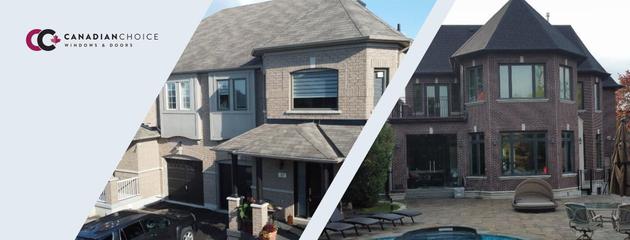Standard Exterior Door Size: A Comprehensive Guide

Key Takeaways:
- Standard exterior door sizes are 80 inches tall x 32 inches wide (single) or 80 inches tall x 64 inches wide (double).
- Interior doors are typically 80 inches tall x 24, 28, 30, 32 or 36 inches wide.
- Patio doors come in sliding, French, bifold, and multi-panel styles with varying standard widths.
- Measure your rough opening and add 2-3 inches for proper door installation clearance.
- Building codes and architectural styles influence door size standards in different regions.
Our experts at Canadian Choice Windows and Doors understand the importance of choosing the right door size for your home. Whether you’re building a new home or renovating, selecting the appropriate door dimensions is crucial for functionality, aesthetic appeal, and building code compliance.
When selecting door sizes, it is also important to consider the door jamb, which is the frame around the door and can affect the overall fit and installation. In this comprehensive guide, we’ll explore standard exterior door sizes, interior door dimensions, and various door styles to help you make an informed decision.
Exterior Door Dimensions
Exterior doors are the gateway to your home, and their size plays a crucial role in both practical and aesthetic considerations. The most common standard exterior door size is 80 inches tall by 32 inches wide for a single door and 80 inches tall by 64 inches wide for double doors. These dimensions are widely adopted by door manufacturers and are designed to accommodate the average height of individuals while providing ample clearance for entry and exit.
However, it’s important to note that exterior door sizes can vary depending on factors such as architectural style, regional building codes, and personal preferences. For instance, some homeowners may opt for taller doors (up to 96 inches) or narrower doors (as narrow as 30 inches) to achieve a specific aesthetic or accommodate unique spaces. Additionally, choosing just the door, also known as a slab door, can be a cost-effective option for those who are handy with a chisel or in situations where the rough opening is already prepared, such as in new construction or when the old jamb is removed.
Entry Doors

Entry doors, also known as front doors, are the focal point of your home's exterior. They set the tone for your home's curb appeal and can significantly impact the overall aesthetic. Here are some common entry door sizes:
| Door Type | Standard Size |
|---|---|
| Single Entry Door | 80 inches tall x 32 inches wide |
| Double Entry Doors | 80 inches tall x 64 inches wide |
| Wide Entry Door | 80 inches tall x 36 inches wide |
When selecting an entry door, consider not only the size but also the material, style, and energy efficiency. Fiberglass, steel, and wood are popular choices, each offering unique advantages in terms of durability, insulation, and aesthetic appeal.
Patio Doors

Patio doors are a beautiful addition to any home, seamlessly blending indoor and outdoor living spaces. These doors come in various styles, including sliding patio doors , French doors, bifold doors, and multi-panel doors. Standard patio door sizes can vary based on the style and configuration:
| Door Type | Standard Size |
|---|---|
| Sliding Patio Door (Two Panels) | 6 feet wide x 6 feet 8 inches tall |
| French Doors (Double) | 5 feet wide x 6 feet 8 inches tall |
| Bifold Patio Door (Four Panels) | 8 feet wide x 6 feet 8 inches tall |
Sliding glass doors, often used as patio or entryways, come in standard measurements of 6 feet wide by 6 feet 8 inches tall for two-panel configurations. They are available in varying sizes based on the installation location and opening dimensions.
When selecting patio doors, consider factors such as the amount of natural light you want to bring into your living space, the ease of operation, and the overall aesthetic you wish to achieve.
Measuring for Door Replacement
When replacing an existing door, it's crucial to accurately measure the rough opening to ensure a proper fit. The rough opening is the unfinished space in the wall where the door frame will be installed. Here's how to measure the rough opening:
- Measure the width at the top, middle, and bottom of the opening.
- Measure the height on the left, center, and right sides of the opening.
- Use the smallest measurements for width and height to determine the rough opening size.
It's generally recommended to add 2-3 inches to the rough opening measurements to account for proper clearance and installation. This extra space allows for easy operation and prevents the door from rubbing against the frame or jamb.
"Proper measurement is the key to a successful door installation. Taking the time to accurately measure the rough opening ensures a seamless fit and optimal functionality." — Angelo Kociper, Director of Sales , Canadian Choice Windows and Doors
Choosing the Right Door Size
When selecting the appropriate door size for your home, consider factors such as the intended use of the space, accessibility requirements, and overall aesthetic goals. For example, bedroom doors may require a narrower width to maximize floor space, while living room doors might benefit from a wider opening for improved traffic flow.
Building codes and accessibility standards may also dictate minimum door width requirements, especially for bathroom doors or entryways to accommodate individuals with mobility challenges.
If you're unable to find a standard door size that meets your specific needs, consider exploring custom door options. Many reputable door manufacturers offer customized solutions to accommodate unique spaces or design preferences.
Exterior Door FAQ
What is the standard door width for exterior doors?
The standard width for a single exterior door is typically 32 inches, while double doors are 64 inches wide. However, wider entry doors measuring 36 inches are also common for a more spacious entryway.
What are the standard dimensions for sliding glass doors?
Sliding glass doors, often used as patio doors, typically have a standard size of 6 feet wide by 6 feet 8 inches tall for a two-panel configuration. These dimensions can vary based on the manufacturer and specific requirements.
Can you provide standard door dimensions for interior doors?
Certainly! Here are some common standard interior door dimensions:
- Closet Doors: 80 inches tall x 24 inches wide
- Bedroom/Bathroom Doors: 80 inches tall x 28 or 30 inches wide
- Passage Doors: 80 inches tall x 32 inches wide
- Wide Passage Doors: 80 inches tall x 36 inches wide
What is the standard thickness for doors?
The standard thickness for most interior and exterior doors is 1-3/8 inches or 1-3/4 inches. However, at Canadian Choice Windows and Doors, we offer custom door options, allowing you to choose the perfect thickness to suit your specific needs and preferences.
Can you explain the difference between a fire door and a regular door?
Fire doors are designed to resist the spread of fire and smoke, providing a barrier between different areas of a building. They are constructed with fire-resistant materials and must meet strict building code requirements. Regular doors, on the other hand, are primarily designed for functional and aesthetic purposes without specific fire-resistance ratings.
What are the benefits of custom doors overstock exterior doors?
Custom doors offer several advantages over stock exterior doors. They allow you to customize the size, material, style, and features to perfectly suit your home's architecture and your personal preferences. Custom doors also provide a unique, tailored look that can enhance your home's curb appeal and overall aesthetic.
Can you clarify the difference between screen doors and storm doors?
Screen doors are primarily designed to allow airflow while keeping insects out. They typically feature a mesh screen panel and are often used in combination with entry doors or patio doors. Storm doors, on the other hand, are more robust and designed to provide an additional layer of protection against severe weather conditions, such as wind, rain, and snow.
How do I determine the correct door opening size for a new door?
To determine the correct door opening size, you'll need to measure the rough opening in your wall. Measure the width at the top, middle, and bottom, and the height on the left, center, and right sides. Use the smallest measurements as the rough opening size. At Canadian Choice Windows and Doors, we can guide you through the process and provide custom door solutions to fit any opening size.
Conclusion
At Canadian Choice Windows and Doors, we understand the importance of finding the perfect door for your home. Our team of experts is dedicated to guiding you through the selection process and providing high-quality products that meet your unique requirements. Contact us today to explore our extensive range of exterior door options and schedule a free consultation.
1000’s of Colours & Textured Finishes
Transform your home from ordinary to extraordinary with our new coloured and non-glare textured finishes. Available in a wide array of colours as well as custom matched colours for your very own personalized design.
Our Most Popular Replacement Window Colours:









